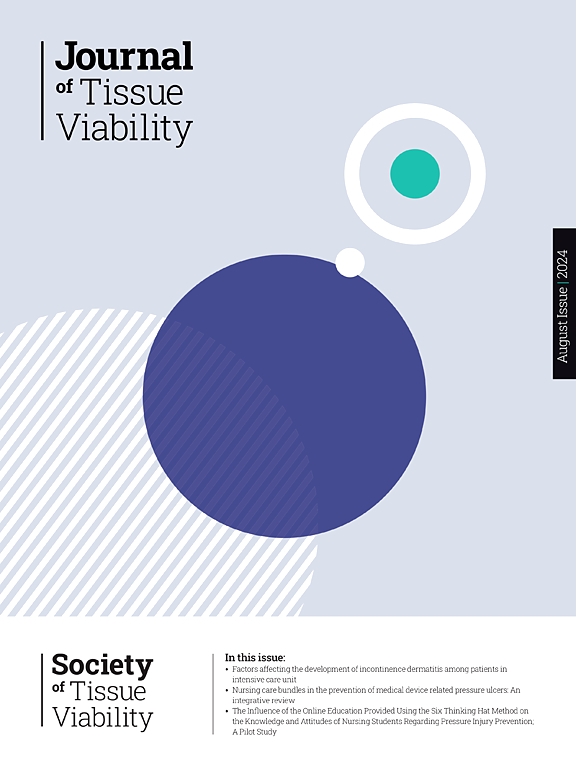Development of a graded management program for patients with diabetic foot ulcers based on the triangle model: A Delphi study
IF 2.4
3区 医学
Q2 DERMATOLOGY
引用次数: 0
Abstract
Objective
To develop a structured nursing intervention program for individuals with diabetic foot ulcers (DFU), utilizing the Triangle Chronic Disease Stratified and Graded Management Model as a core framework.
Design
A Delphi study.
Settings
The semi-structured interview and preliminary formulation were carried out within the endocrinology department of a tertiary hospital located in Anhui Province, China.
Participants
Ten endocrinologists, two specialists in wound repair, one expert in chronic illness management, one health education specialist, and one sports rehabilitation expert from China's endocrinology and wound repair surgical departments.
Methods
Potential elements for the draft were selected via literature review, and the specific content, needs, challenges, current circumstances, and barriers associated with the stratified management of patients with diabetic foot ulcers (DFU) were elucidated through interviews with 16 patients and 15 medical professionals. Following four rounds of online discussions among the research team, a correspondence questionnaire for Delphi experts was meticulously crafted using the Triangle Chronic Disease Hierarchical Management Model. The questionnaire was disseminated through email to 15 domestic experts in the field from October 2023 to March 2024. The expert positive coefficient, authority coefficients, and Kendall's concordance coefficients were employed to evaluate the dependability of the graded management program. The consultation ended when expert viewpoints aligned.
Results
A total of twenty-two literature sources were integrated, and interviews were conducted with sixteen DFU patients and fifteen medical personnel before the questionnaire was developed. The program experienced two iterations of collective evaluation and feedback. The response rate for both rounds of expert consultation reached an impressive 100 %. The coefficients of expert authority were recorded at 0.80 and 0.81, respectively. The concordance coefficients calculated by Kendall for the significance and feasibility of the items across the two consultation rounds were 0.271 and 0.183 (P < 0.001), and 0.283 and 0.237 (P < 0.001), respectively. The management program comprises 80 items, systematically classified into three distinct components: i) Organizational structure, ii) Stratification standards, and iii) Grading measures. The composition comprised three principal entries, nine subordinate entries, and sixty-eight ancillary entries.
Conclusion
Our findings suggest that the graded management program for patients with DFU demonstrates a significant degree of scientific rigor, reliability, practicality, and feasibility. This approach tackles the individualized care requirements of DFU, potentially offering a systematic, evidence-based, and practical hierarchical management framework for clinical nursing. The aim is to reduce the rates of readmission and amputation, while simultaneously improving quality of life and overall prognosis.
基于三角模型的糖尿病足溃疡分级管理方案的发展:德尔菲研究
目的以三角慢性病分层分级管理模式为核心框架,制定糖尿病足溃疡患者的结构化护理干预方案。设计Delphi研究。半结构化访谈和初步制定在中国安徽省某三级医院内分泌科进行。参与者:来自中国内分泌科和伤口修复外科的内分泌专家10人,伤口修复专家2人,慢性疾病管理专家1人,健康教育专家1人,运动康复专家1人。方法通过文献综述的方式选择草案的潜在要素,并通过对16名患者和15名医疗专业人员的访谈,阐述糖尿病足溃疡(DFU)患者分层管理的具体内容、需求、挑战、现状和障碍。在研究小组进行了四轮在线讨论之后,德尔福专家的通信问卷被精心制作,使用三角慢性病分层管理模型。问卷于2023年10月至2024年3月通过电子邮件向15名国内该领域专家发放。采用专家正系数、权威系数和肯德尔协调系数来评价分级管理方案的可靠性。当专家们的观点一致时,协商结束了。结果在编制问卷前,共整合22篇文献,对16例DFU患者和15名医护人员进行访谈。该计划经历了两次集体评估和反馈的迭代。两轮专家咨询的回复率都达到了令人印象深刻的100%。专家权威系数分别为0.80和0.81。Kendall计算的两轮咨询项目的显著性和可行性的一致性系数分别为0.271和0.183 (P <;0.001), 0.283和0.237 (P <;分别为0.001)。管理方案包括80个项目,系统地分为三个不同的组成部分:i)组织结构,ii)分层标准,iii)分级措施。论文由3个主条目、9个从属条目和68个辅助条目组成。结论DFU患者分级管理方案具有较高的科学严谨性、可靠性、实用性和可行性。这种方法解决了DFU的个性化护理需求,有可能为临床护理提供系统的、循证的、实用的分层管理框架。目的是降低再入院率和截肢率,同时改善生活质量和总体预后。
本文章由计算机程序翻译,如有差异,请以英文原文为准。
求助全文
约1分钟内获得全文
求助全文
来源期刊

Journal of tissue viability
DERMATOLOGY-NURSING
CiteScore
3.80
自引率
16.00%
发文量
110
审稿时长
>12 weeks
期刊介绍:
The Journal of Tissue Viability is the official publication of the Tissue Viability Society and is a quarterly journal concerned with all aspects of the occurrence and treatment of wounds, ulcers and pressure sores including patient care, pain, nutrition, wound healing, research, prevention, mobility, social problems and management.
The Journal particularly encourages papers covering skin and skin wounds but will consider articles that discuss injury in any tissue. Articles that stress the multi-professional nature of tissue viability are especially welcome. We seek to encourage new authors as well as well-established contributors to the field - one aim of the journal is to enable all participants in tissue viability to share information with colleagues.
 求助内容:
求助内容: 应助结果提醒方式:
应助结果提醒方式:


